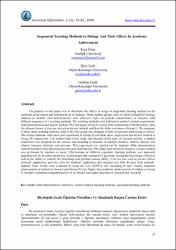| dc.contributor.author | Özay, Esra; Ocak, İjlal; Ocak, Gürbüz | |
| dc.date.accessioned | 2019-02-05T08:31:31Z | |
| dc.date.available | 2019-02-05T08:31:31Z | |
| dc.date.issued | 2009 | |
| dc.identifier.citation | | en_US |
| dc.identifier.uri | http://dergipark.gov.tr/download/article-file/304124 | |
| dc.identifier.uri | https://hdl.handle.net/11630/5348 | |
| dc.description | The purpose of this paper was to determine the effects of usage of sequential teaching method on the academic achievement and retention level of students. Three student groups, each of which included 20 biology students in Ataturk University-Erzurum, were offered a topic on general characteristics of enzymes with different sequences of 3 teaching methods. The teaching methods were Laboratory method (student experiment), slide demonstration and lecture method. The first group started to course with experiments in the laboratory, then the relevant theory of enzyme was given lecture method, and then the slides was shown (Group I). The sequence of these three teaching methods used in the first group was changed in both second and third group as follow: The lecture methods, slide show and experiment in Group II, and slide show, experiment and lecture method in Group III, respectively. Lab method used in the study was focused on the topic of enzymic activity. a student experiment was designed for this reason, and including to examine its catalytic features, effective factors, and relation between substrate and enzymes. This experiment was carried out by students. Slide demonstration method included slides about enzyme structure and function. The slides were shown by teachers. Lecture method was performed by teachers as usual. Effectiveness of different sequential teaching methods was measured quantitatively by an achievement test. Achievement test contained 25 questions, testing the knowledge of facts as well as the ability to transfer the knowledge and problem solving ability. This test was used as pre-test before methods’ application, post-test after the methods’ application and retention test after 40 days from methods’ applied. Tests’ results were evaluated by using one way ANOVA test. According to tests’ results, academic achievements of student in Group I and Group III were higher than academic achievements of student in Group II. Student’s retention (remembrance) level in Group I was higher than that of Group II and Group III. | en_US |
| dc.description.abstract | Bu çalışmanın amacı biyoloji öğretim metotlarının kullanım sırasının öğrencilerin akademik başarısında ve hatırlama seviyelerindeki etkisini belirlemektir. Bu amaçla birinci sınıf Atatürk üniversitesi biyoloji öğrencilerinden 20 kişi içeren 3 grup üzerinde 3 öğretme metodunun kullanım sırası değiştirilerek enzim konusunun genel karakteristiği anlatılmıştır. Öğretim metotları laboratuar uygulaması, gösteri (slayt, demonstrasyon) ve düz anlatımdır. Birinci grup derse laboratuar da deney ile başladı, sonra enzim konusu ile ilgili teorik bilgi düz anlatım ile verildi ve sonra slayt gösterildi (Grup I). Birinci grupta kullanılan bu üç öğretim metodunun sırası ikici grupta değiştirildi. İkinci grupta ders düz anlatım ile başlatıldı, sonra slayt gösterisi kullanıldı ve en son öğrenciler tarafından deney yapıldı (Grup II). Üçüncü grupta yine bu üç öğretim metodunun sırası değiştirildi ve ders slayt gösterisi ile başlatıldı, sonra deney yapıldı ve en son düz anlatım yapıldı (Grup III). Laboratuar uygulaması, enzimlerin katalitik özellikleri, çalışmalarına etki eden faktörleri ve enzim-substrat ilişkisini kapsayan, katalaz enzimi ile yapılan bir öğrenci deneyidir. Bu deney öğrenciler tarafından yürütüldü. Gösteri ise enzimin yapısını ve fonksiyonlarını gösteren slaytlar şeklindedir. Bu slaytlar öğretmen tarafından sınıfa gösterildi. Düz anlatım ise öğretmen tarafından bir konferans niteliğinde sunulur. Değişik sıralı metotların etkisi bir başarı testi ile nicel olarak ölçüldü. Başarı testi, 25 maddelik olup bilgi yanında, bilginin transferi ve problem çözme yeteneğini ölçmektedir. Bu test örneklem gruplarına konu sunulmadan önce ön test, konu sunulduktan sonra son test ve son testten 40 gün sonra kalıcılık (hatırlama) testi olarak üç kere uygulanmıştır. Sonuçlar tek yönlü varyans analizi testi kullanılarak değerlendirilmiştir. Testten elde edilen sonuçlara göre, Grup I ve Grup III ‘ün akademik başarıları Grup II’ nin akademik başarısından daha yüksektir. Grup I’ deki öğrencilerin kalıcılık düzeyleri ise Grup II ve Grup III’ deki öğrencilerin kalıcılık düzeylerinden yüksektir. | en_US |
| dc.language.iso | eng | en_US |
| dc.rights | info:eu-repo/semantics/openAccess | en_US |
| dc.subject | Slayt gösterimi, laboratuar, düz anlatım, öğretim metotları, sıralı öğretim metotları | en_US |
| dc.title | Biyolojide Sıralı Öğretim Metodları Ve Akademik Başarı Üzerine Etkisi | en_US |
| dc.title.alternative | Sequential Teaching Methods In Biology And Their Effects In Academic Achievement | en_US |
| dc.type | article | en_US |
| dc.relation.journal | Kuramsal Eğitimbilim Dergisi | en_US |
| dc.department | Afyon Kocatepe Üniversitesi | en_US |
| dc.identifier.volume | 2 | en_US |
| dc.identifier.startpage | 32 | en_US |
| dc.identifier.endpage | 43 | en_US |
| dc.identifier.issue | 2 | en_US |
| dc.relation.publicationcategory | Makale - Ulusal Hakemli Dergi - Kurum Yayını | en_US |



















